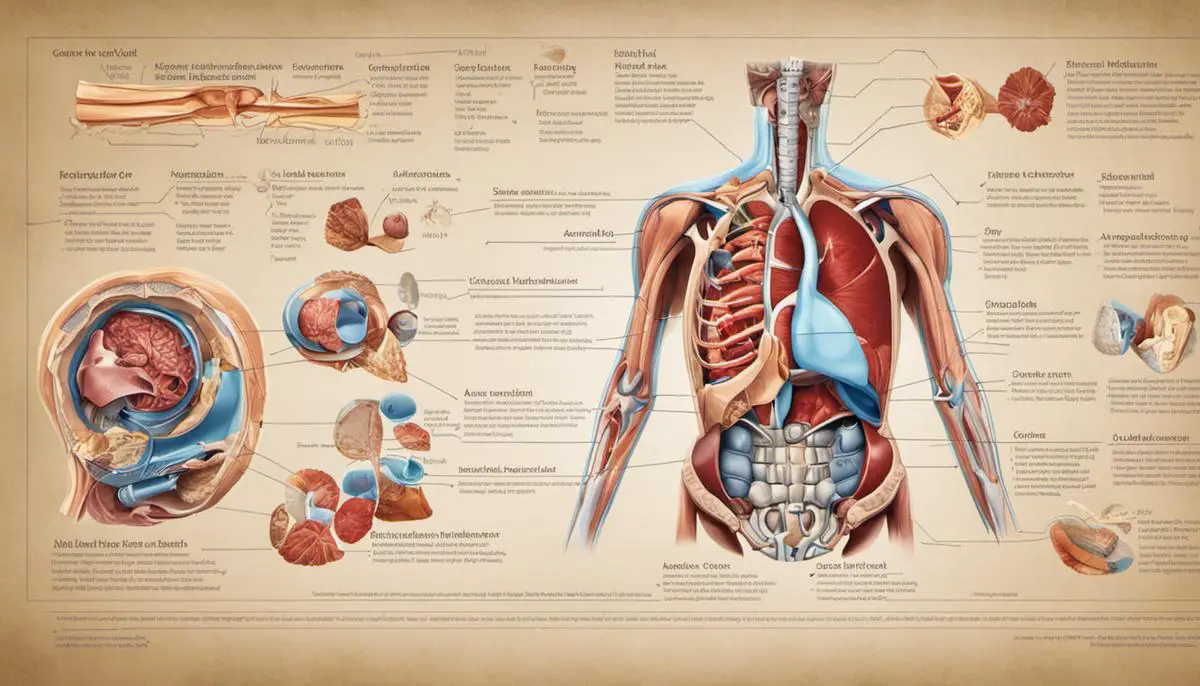Embarking on the journey towards a stronger and tighter abdomen requires more than just physical effort; it necessitates a comprehensive understanding of the anatomy of the abdomen, the effectiveness of various exercises, and the integration of an overall fitness routine. Furthermore, recognizing how nutrition can bolster your progress is just as vital. Arm yourself with the knowledge about the unique roles and functions of different abdominal parts and how specific workouts enhance them. Navigate through this view of anatomy that forms the basic platform from which to build a potent abdominal workout.
Understanding the Anatomy of the Abdomen
Understanding the Anatomy of the Abdomen
The abdominal region, commonly referred to as the core, houses many different muscles that work together to support the trunk of the body and allow for the wide range of movements the human body can make. Understanding the anatomy of these muscles can help highlight the importance of different exercises when targeting these specific areas.
The Rectus Abdominis
One of the most famous abdominal muscles is the rectus abdominis. This is the muscle most people refer to when they talk about the “six-pack.” This muscle runs from the sternum down to the pubic bone and is used in movements involving flexing the spine, like when you perform a crunch.
The Transversus Abdominis
The deepest muscle of the abdominal wall is the transversus abdominis. This muscle is often overlooked, but plays a crucial role in providing support to the spine. It wraps around the torso from front to back and from the ribs to the pelvis, functioning like a weight belt keeping your insides in.
When you inhale and exhale deeply, the transversus abdominis flattens and draws in, working similarly to a corset. Strengthening this muscle through exercises like planks can help improve posture and reduce lower back pain.
The External and Internal Obliques
Along the sides of your trunk are the external and internal oblique muscles. These muscles aid in trunk rotation and lateral flexion of the spine, as in side bending. They are crucial for activities that require twisting like golf or basketball.
The external obliques are closer to the skin, while the internal obliques lie beneath them. Exercises that target these muscles typically involve some sort of twisting or rotating movement, such as Russian twists.
How workouts affect these muscles
Various abdominal exercises target different muscles within the core. For example, traditional crunches primarily target the rectus abdominis. However, adding a twist to the crunch can also engage the internal and external obliques. Planks, on the other hand, target all layers of the abdominal muscles, with particular emphasis on the transversus abdominis.
It’s important to understand that working out these muscles can not only improve your appearance but also enhance your overall physical performance, prevent back pain and even aid in breathing and other basic bodily functions. Conceptually, a stronger core works as the power center of the body, assisting practically every movement.
Overall, knowing your anatomy can help you understand the importance of a diverse and comprehensive abdominal workout routine that targets each of these muscle groups effectively.

Identifying Effective Abdominal Exercises
Identifying Effective Abdominal Workouts
To identify effective abdominal exercises, we must first understand that the abdomen comprises multiple muscle groups. The four major ones are the rectus abdominis (running vertically in the front), the external and internal obliques (on the sides), and the transverse abdominis (the deepest muscle that wraps around the spine).
The effectiveness of an abdominal workout depends not just on the intensity but also on the variety of exercises that encompass all these muscle groups. Here are a few examples:
The Plank
The plank is a highly effective core workout because it both strengthens and stabilizes the torso by engaging a multitude of muscles, including all layers of abdominal muscles. To perform a plank, get on all fours in a push-up position and hold this pose for as long as you can. Keep a straight body line from your head to heels without drooping your hips or arching your back. You can increase the intensity by extending your body on a ball.
The Crunch
Crunches mainly target the rectus abdominis but also engage other abdominal muscles. To do a crunch, lie flat on your back with your knees bent and feet on the floor. Then, curl your shoulders towards your pelvis while keeping your back flat on the floor. For an effective workout, you can add variations like twisting crunches, reverse crunches, or medicine ball crunches.
The Bicycle Crunch
The bicycle crunch exercise targets nearly all of your abdominal muscles, with a particular emphasis on the obliques. To do a bicycle crunch, lie flat on your back, bring your hands behind your head, and lift your knees. Then, bring your right elbow towards your left knee while straightening your right leg, and then do the opposite for the next rep.
The Russian Twist
The Russian Twist is another excellent exercise that targets your obliques and other abdominal muscles. To do a Russian Twist, sit on the ground with your knees bent, pull your abs to your spine, and lean back a few inches while keeping your back straight. Hold your hands at your chest, and then twist your torso to one side, then to the other.
Ab Roller Workout
A workout using the ab roller engages the rectus abdominis, obliques, and transverse abdominis. While on your knees, hold an ab roller beneath your shoulders, slowly roll the ab roller out away from your body, extending your arms, and then slowly roll back to your knees. Start slowly and carefully to avoid back strain.

Creating a Balanced Workout Plan
Determining Your Level of Fitness
The first key point to delve into is knowing your own level of fitness. This does not only base on your daily activities but includes simple elements such as if you can take a flight of stairs without getting winded. Assess yourself realistically and move from there. Abdominal workouts can be physically demanding. If you’re new to working out or if you haven’t been active in a while, it may be beneficial to get a physical exam or to consult with a healthcare provider before starting a new workout regimen.
Designing a Balanced Workout Routine
To create a balanced workout plan, you need to include exercises that challenge all major muscle groups. This involves the chest, back, shoulders, arms, legs, and of course, your abdomen. By alternating exercise days, you’ll give specific muscle groups time to recover while you work others. This prevents overstraining one particular group of muscles.
Implementing Effective Abdominal Workouts
There are a host of effective abdominal workouts for men. These include traditional sit-ups, planks, abdominal crunches, and leg raises. Incorporating weighted exercises such as cable crunches or using gym machinery like the captain’s chair will improve abdominal muscle strength and definition. Start out slowly and increase intensity gradually. This is crucial for preventing muscle strain and injury.
Benefits of Alternating Exercise Days
By not working the same muscles continuously and allowing a day or two for recovery, you not only prevent injuries but maximize the muscle-building process. It’s during these recovery periods that actual muscle growth occurs. Workouts cause micro-tears in muscle tissue. The body repairs these tears during rest periods, leading to stronger muscles over time.
Importance of Rest
It can’t be overstressed how essential rest is in any workout routine. The body needs time to recover after the stress of exercise. Having a good sleep routine provides your body additional recovery time and promotes overall well-being. In addition, a nutritious diet plays a vital role in muscle recovery and growth.
Inclusion of Cardio Exercises
While lifting weights and strength training is important, cardio exercises should not be neglected in your balanced workout routine. Cardio exercises can help you lose excess fat, which enables your muscle growth and definition to really shine through. Running, biking, or swimming are good cardio options. Even a brisk walk can serve as a cardio workout.
Remember, it is always safer and more effective to start slow and increase intensity as your fitness improves. It is also important to be consistent to make meaningful progress. And above all, listen to your body. It’s the best indication of when to stop or slow down.

Photo by jareddrice on Unsplash
Mindful Nutrition for Muscle Toning
Menu Planning for Muscle Toning
Menu planning is initially a critical factor to enhance muscle toning. Select nutrient-rich foods that are high in protein, like lean meats, beans, eggs, and low fat dairy. Quinoa, chicken breast, and fish are also excellent lean protein sources that aid in muscle building and toning. Additionally, consuming these foods in moderate portions throughout the day can maintain efficient metabolism, and avoid overeating.
Importance of Hydration in Muscle Building
Water plays a crucial role in fueling your workouts and helping your muscles recover afterwards. It also helps in maintaining your form during the abdominal exercises. Men should aim for approximately 3.7 liters a day according to the National Academies of Sciences. Consuming adequate amounts of water can aid digestion, help manage your weight, and enhance your workout performance.
Carbohydrates and Fats for Building Abdominal Muscles
While you might be intent on shedding abdominal fat, it’s crucial not to eliminate fats entirely from your diet as they’re important for hormonal balance and producing energy. Opt for healthy fats like avocados, nuts, seeds, and olive oil instead of unhealthy snacks or fried food. On the other hand, carbohydrates provide the necessary energy for working out. Complex carbohydrates, such as those from whole grains, fruits, and vegetables, are preferable as they offer sustained energy release.
The Critical Role of Protein for Abdominal Toning
Protein is essential for muscle recovery and growth and should make up a significant portion of your nutrition when trying to tone and build muscles. Consuming high-quality protein after workouts can help repair muscle tissue and promote the growth of new muscle. Opt for lean proteins, such as skinless chicken, lean red meat, fish, eggs, and plant-based proteins like lentils and chickpeas.
Understanding Portion Control for Optimum Results
Lastly, portion control is critical in maintaining a balanced diet. Whether you’re trying to build muscle or lose fat, too much of anything isn’t beneficial. For example, consuming excessive protein can lead to it being stored as fat, while insufficient protein can hinder muscle growth and recovery. Using smaller plates or bowls can be a handy tool in managing portion sizes.
The Importance of Regular Exercise Alongside Mindful Eating
A balanced, nutrient-rich diet combined with consistent and targeted exercise is the key to successful abdominal muscle toning. Regularly performing effective abdominal exercise workouts, such as planks, crunch twists, and leg raises, accompanied by mindful eating practices, can greatly improve your muscle toning results.

With a clear understanding of both the anatomy of your abdomen and the exercises best suited to work those muscles, coupled with a thoughtful balance in your workout routine and mindful nutrition, achieving your desired abdominal results is well within your grasp. This fitness journey is far more intricate than just going through the motions physically – it is a multifaceted commitment to your overall health and wellness. Keep pushing, stay educated, and remember that every meal and every rep brings you one step closer to your goal.
